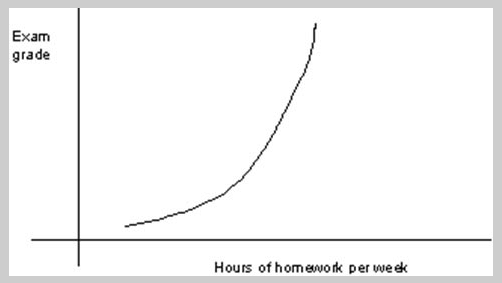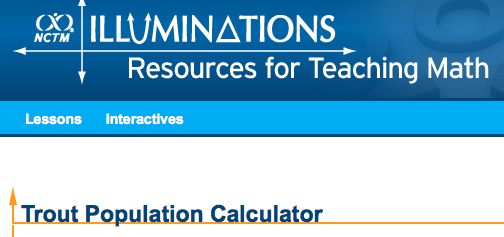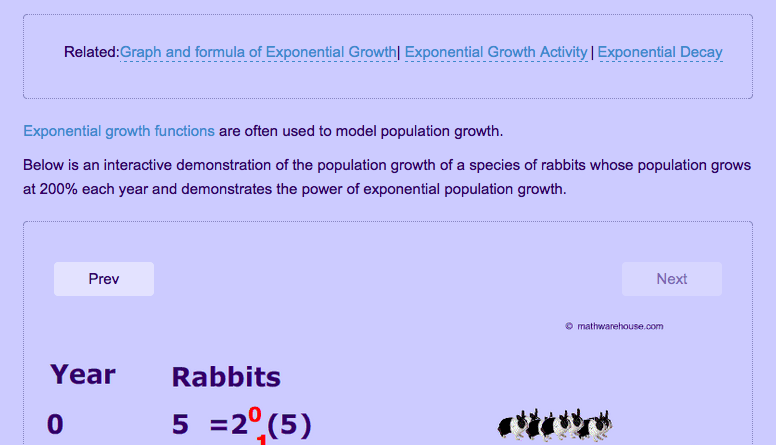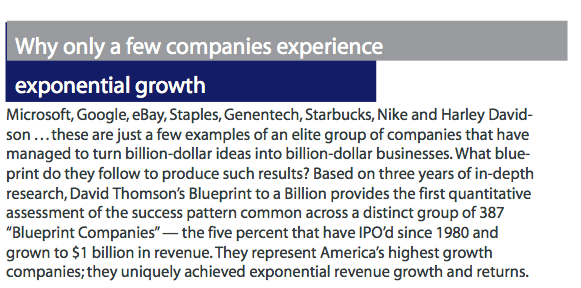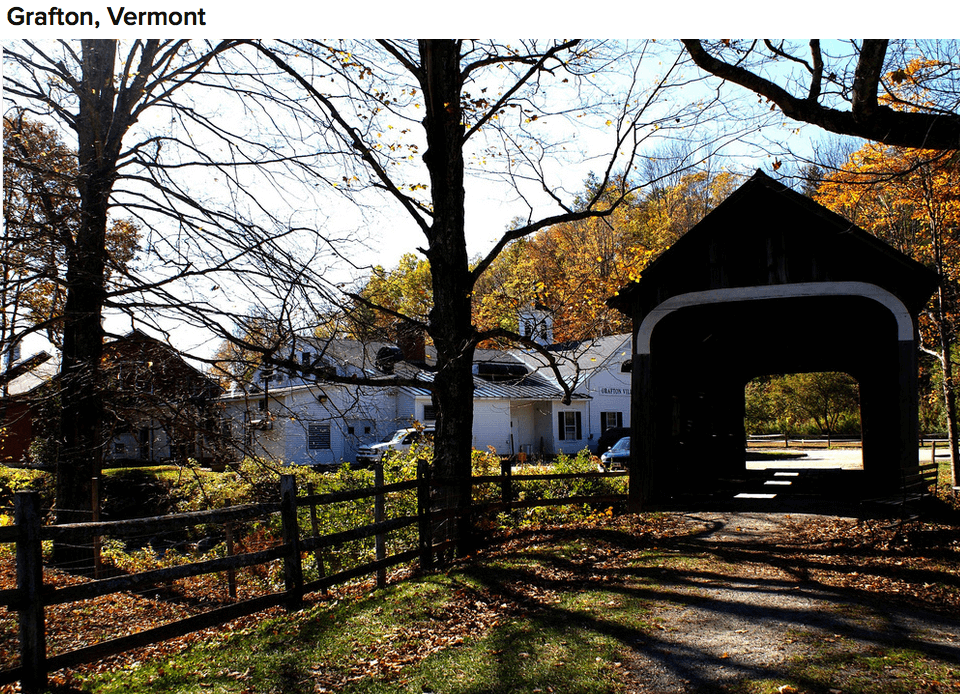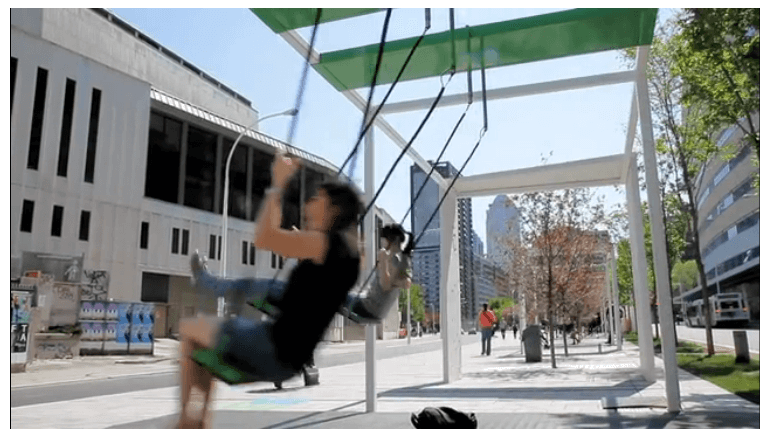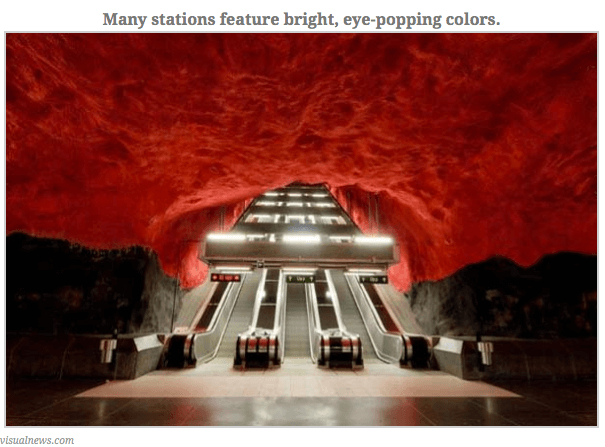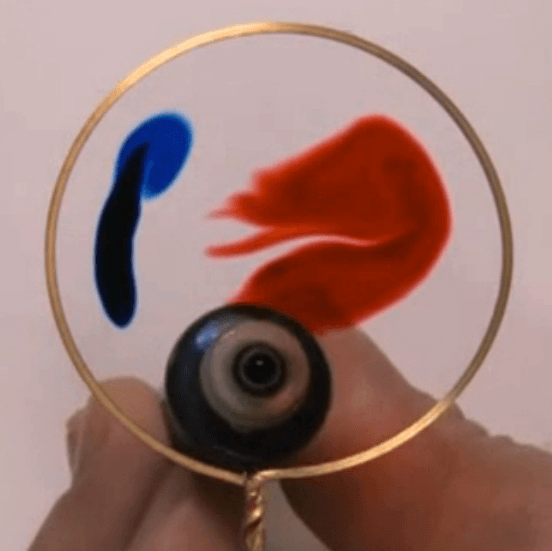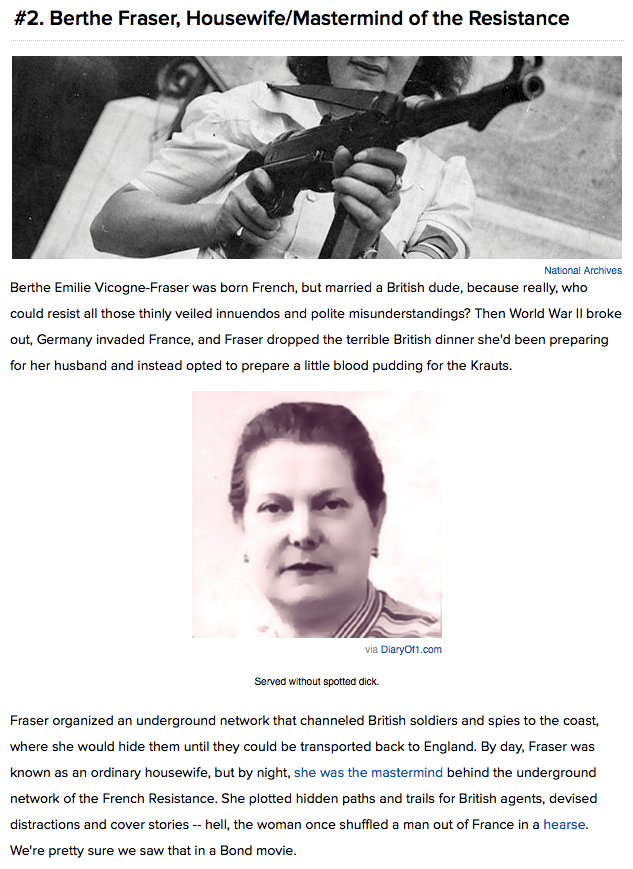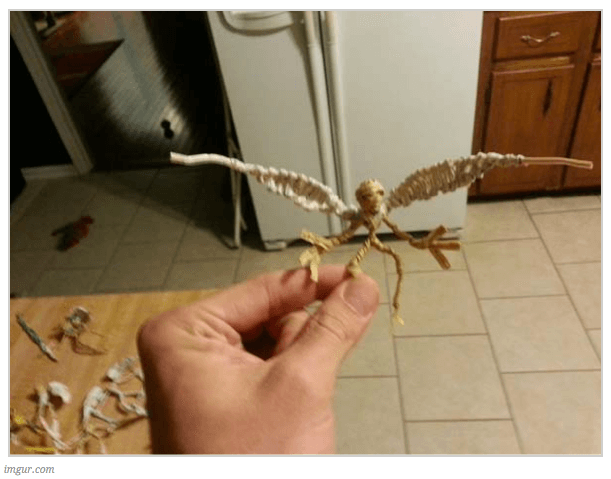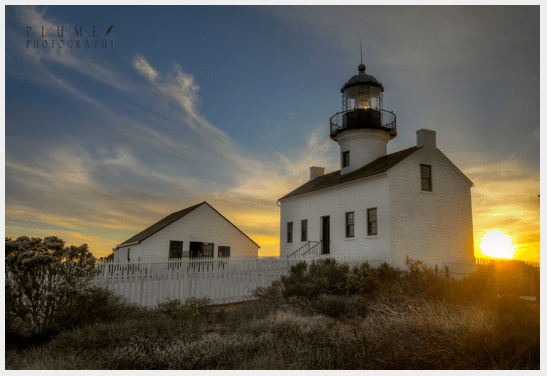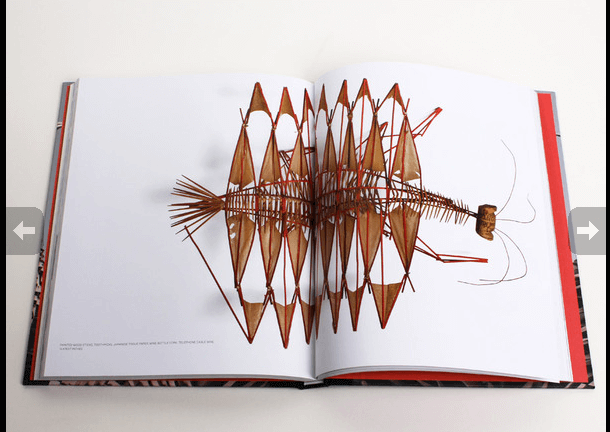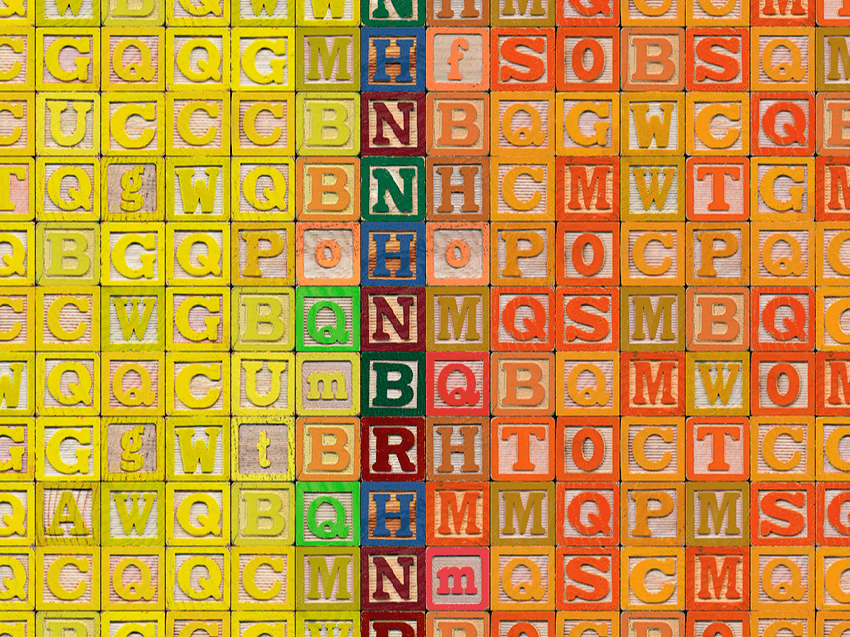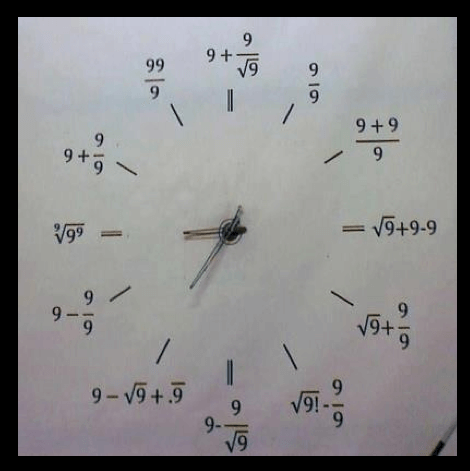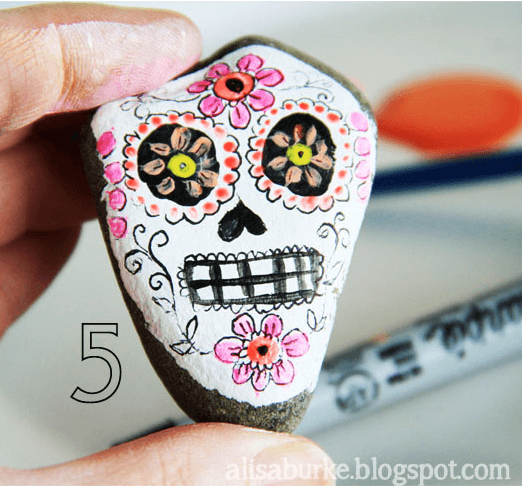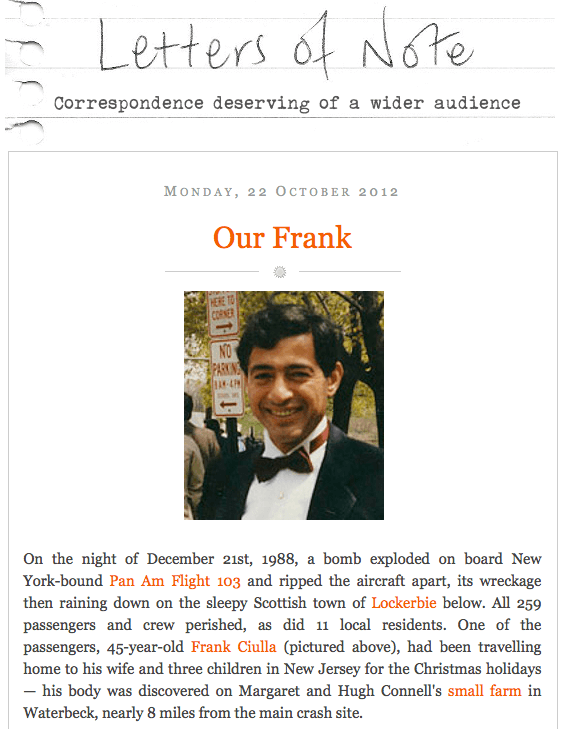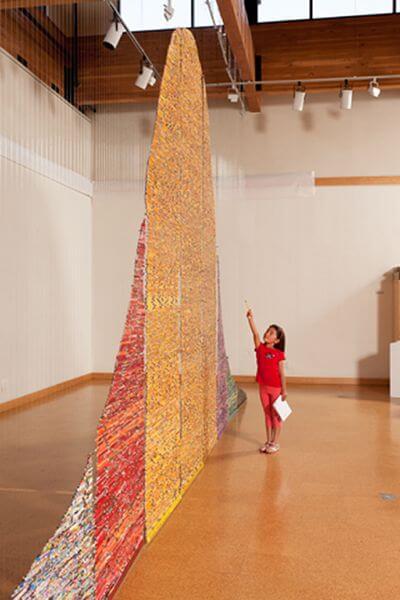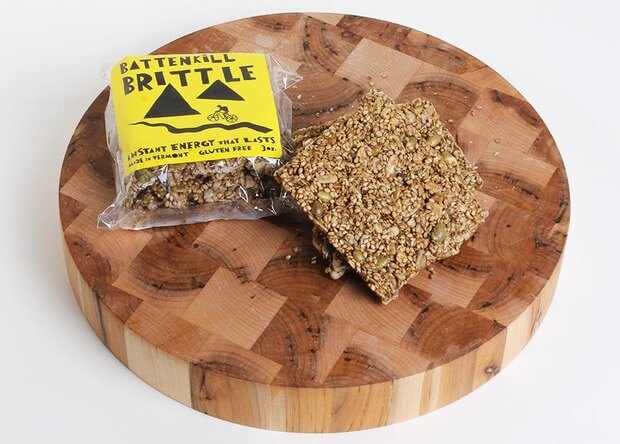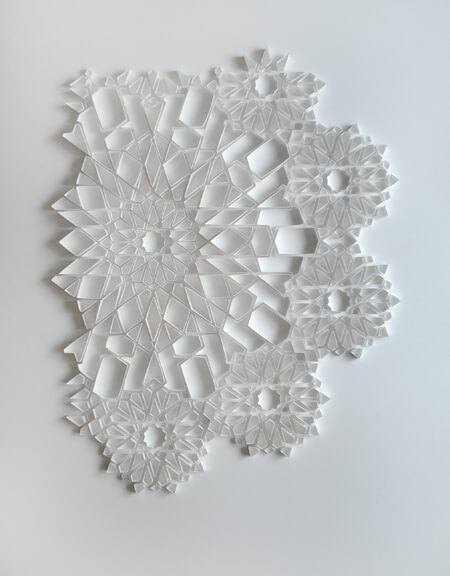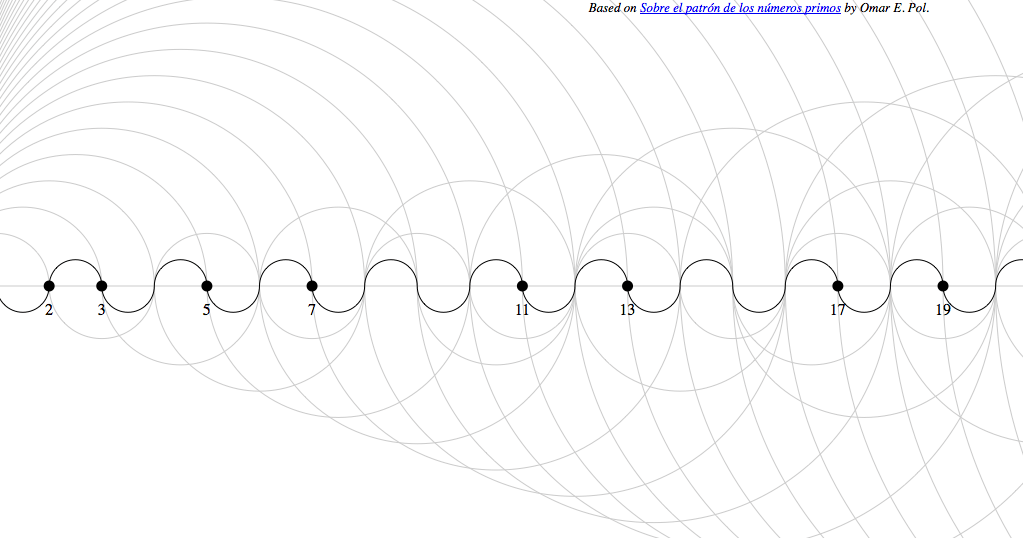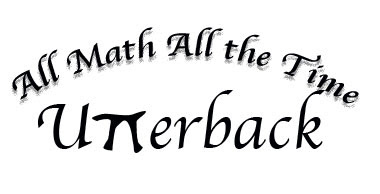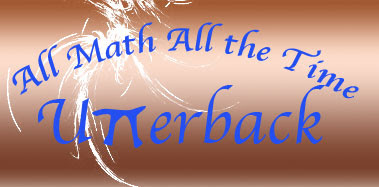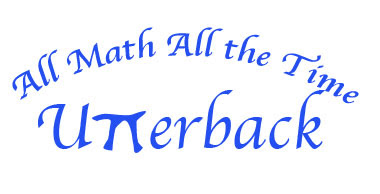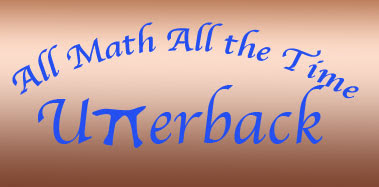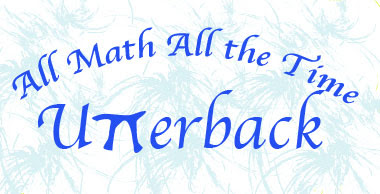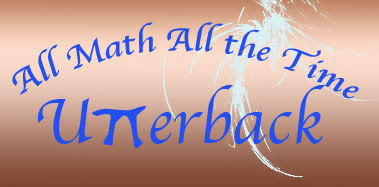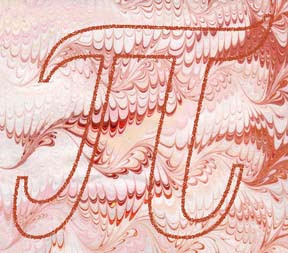Archive for the ‘math’ Category
Algebra Unit: Exponential Relationships
Brief note: a time-out from art-related items to post an assignment for a Coursera class for assessment by peers.
Unit: Exponential Relationships
9th grade, but 8th graders are welcome!
Investigation 1: Exponential Growth
Welcome to our new unit in Connected Math, Exponential Relationships! We have five different investigations, and you will find yourself doing a lot of comparisons of exponential relationships with linear relationships. (Told you linear would never go away!) You can see an overview of the unit by clicking on the link above to see the parent information letter. DO NOT WAIT TO GET YOUR NEW UNIT BOOK from your district office – you don’t want to get behind!!
Here are two key pieces we will focus on:
- * Is the relationship between variables an example of exponential growth or decay? Why?
- • How can this relationship be detected in a table, graph, or equation? What is the growth factor?
- • What table, graph, or equation would model the data or the pattern in a graph relating the variables?
- • How could I answer questions about an exponential situation by studying a table, a graph, or an equation of the exponential relationship?
- • How does this exponential relationship compare to other relationships between variables I have studied?
- You will need: scissors and a sheet of paper (regular paper is fine, and you might be happier with a blank sheet)
- Your journal for record-keeping, notes, and solving problems
- A new anchor chart for vocabulary on a separate page in your journal – use a stickie tab on the page for easy reference to it.
- [Reference for peer readers on anchor charts – http://www.julieballew.com/A_Literate_Life/Photos/Pages/Anchor_Charts.html. Students will have other samples, since what I use I cannot share publicly (only in a classroom/online teaching setting) because of proprietary agreement with past employer)].
14. Continue working on homework problems for this investigation: Practice problems on page 11 – 18: Everyone do #1-14, and then 3 others of your choice. Everyone do #33 – 38. (Due at the end of the week.)
Deadlines:
- HS.F-LE.A.1a. Distinguish between situations that can be modeled with linear functions and with exponential functions.
- HS.F-LE.A.1b. Prove that linear functions grow by equal differences over equal intervals, and that exponential functions grow by equal factors over equal intervals.
Mathematical Practice Standards:
- 1. Make sense of problems and persevere in solving them.
- 2. Reason abstractly and quantitatively.
- 3. Construct viable arguments and critique the reasoning of others.
- 4.Model with mathematics.
- 5.Use appropriate tools strategically.
- 6.Attend to precision.
- 7.Look for and make use of structure.
- 8.Look for and express regularity in repeated reasoning.
Copyright notice: all links are public domain and links are included by clicking on pictures. This unit is directly from Connected Math 2, published by Pearson. The conversion to an online format is the work of the instructor, Linda Moran, and cannot be reproduced without permission of the instructor.
Top Ten Tuesday
 Spring in the desert! In fact, it is almost summer – 91 today, and I think we will break down and put the air conditioner on for a bit this afternoon. Went through Saguaro National Park on Sunday tosee the cactus in bloom – always a treat this time of year. I still have lots in the bookmarks for cool stuff on line. So sit back and enjoy!
Spring in the desert! In fact, it is almost summer – 91 today, and I think we will break down and put the air conditioner on for a bit this afternoon. Went through Saguaro National Park on Sunday tosee the cactus in bloom – always a treat this time of year. I still have lots in the bookmarks for cool stuff on line. So sit back and enjoy!
Hubby and I have always been a fan of Roy Orbison, and he especially of k.d. lang, so here’s the two combined.
I loved this next site, especially since we are planning to move back to Vermont in about a year. New England towns – they sure are gorgeous!
I am not a tattoo person – never have been, but I certainly can recognize art when I see it – even if it is a little creepy……
Swinging hits new heights (sorry, couldn’t resist), but an interesting take on cooperativeness.
Subway art in Sweden – makes transportation into an art experience.
Water sheets in space – – an experiment on the space station.
Some untold stories of World War II:
Seriously LOVE the Fibonacci numbers…..check this out!
Incredible pics of icebergs – they’re actually paintings…..
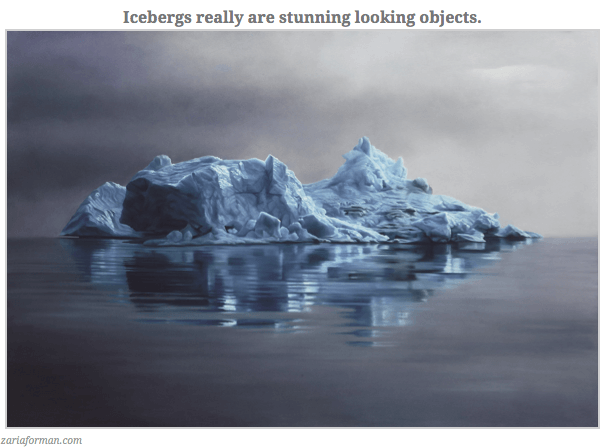
And finally, the utmost in recycling – twist-tie toys!
Top Ten Tuesday
It has been a bit, what with the holidays and all, but I am slowly getting back to being regular with the blogging. Mostly I’ve found some really cool videos that I hope I can get up here. Enjoy, and send me what you find on line.
First up is eye candy from the 365 Project. I’ve actually been to this spot – during the day, but it is gorgeous at sunset.
Also from 365 Project are their theme winning photographs for the year. The math person in me loves this geometry winner.
From Cool Hunting comes a look at a paper artist, Irving Harper. I love the texture that he is able to create.
Here is a pretty amazing video of driving in Norway along the Atlantic Coast. How would you like the job of building this road?? The road is built on several small islands and reefs, and is crossed by eight bridges, several roads and overpasses. This road is a view of the open sea, which is rare on the roads along the Norwegian coast. You can see fjords and mountains near the road. The spectacular road quickly became a tourist attraction, insofar precautions should be displayed while driving, because of the attendance of the road by the local population and visitors.
This is reminiscent of the art of Andy Goldsworthy, but even more fleeting. This is the balancing art of Michael Grab, from NPR.
Ice palaces in Harbin, China – really gorgeous…..and oh, so cold!
I LOVE Chris Jordan, and he has some new work available on his website. He uses common objects to depict waste of one type or another to tell a story. He is amazing. Be sure to zoom in on each picture.
School Dropouts…..done in blocks
New video from recreational mathematician Vi Hart – whom I absolutely love – use her videos in college algebra a lot! Here’s a look at fractals….
Speaking of math, I thought this was pretty cool: (If you know the source, please let me know….)
And finally, one of my favorite math videos on how easy it is to misunderstand some of the basics of mathematics……
Have a great week!
Top Ten Tuesday
An interesting web week…watched a lot of humor on YouTube, as well as a lot of math videos for my algebra class. Here’s one on exponential functions in real life – earthquakes.
A tour of the Google Data Center – colorful, just like the logo!
How cool are these! From Alisa Burke – stone sugar skulls!!
This from Letters of Note is heartbreaking. A reminiscence of the Pam Am explosion over Lockerbie, Scotland.
Interested in education issues? Harriete talks about a show opening that deals with standardized testing. If you are at all familiar with the bell curve, you’ll appreciate one of the art works.
This juggling is fabulous!!!! One ball, who knew?
A whale of a tale, from the Great Whale Conservancy – beautiful story.
Put Johnny Carson and Dom DeLouise together, along with some raw eggs, and it’s just hilarious! They don’t make ’em like this any more!!
If you are not familiar with Design Seed, check out the interesting color combinations – some colors I would never have thought to put together.
And finally, if you haven’t visited Craft Gossip, you need to put it on your lists. Posts every day, and then some! Lots of great craft ideas to try, especially for and with kids.
 That’s it for this week. Send along great links that you find out there on the web!
That’s it for this week. Send along great links that you find out there on the web!
Top Ten Tuesday
So I am not a video gamer. Couldn’t even master Pac-Man, and I hurt my wrist trying Frogger. Plus, I hate the amount of violence in video games. This week I discovered an article about a gun-free video game. Who knew? Called the Unfinished Swan, it has lots of elements of art within it. Fascinating.
“Ian Dallas was a comedy writer who cut his teeth at the Yale Record, then The Onion, before moving into TV and working on Comedy Central’s Drawn Together. But his plan was always to make video games. So he went to grad school and created a prototype for an unusual game wherein players are confronted with a white void of a world to which they give form by splattering paint around to reveal the objects and environment around them. ”
I’m finally working through all the cool things from Cool Hunting. Here’s a neat item from Vermont: Battenkill Brittle, gluten-free energy bars, and they look yummy.
Here’s a wonder of the world a lot of people don’t know about: The amazing Bay of Fundy in time-lapse.
Have trouble with deciding what colors look good together? Check out Design Seeds – a collection of pictures that have identified the color palette within. Lots of inspiration here.
From Origami Joel comes another very interesting paper artist, Matt Shlian. Absolutely beautiful!
The Biological Advantage of Being Awestruck – beautiful video from my friend Amethyst, who minored in the philosophy of science. It sounds like she did some incredibly interesting reading in those classes! I could take those classes now…..
This is an interesting blog from the Surface Design Association on feng shui for your studio. I need to reread this at lenght, and I also think I will investigate the books she mentions efore I look at repurposing the garage into a wet dye studio.
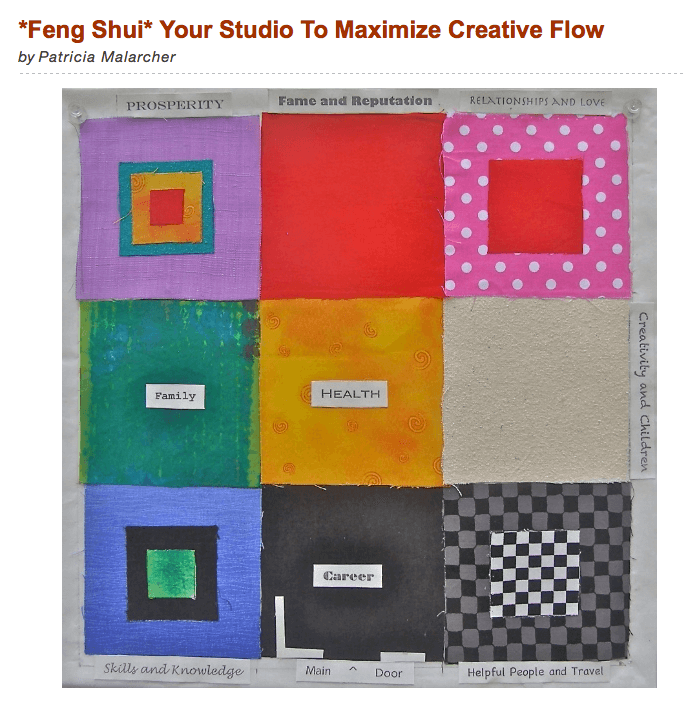 Jamie Ridler guides artists to authentic creative living. Here’s a post about learning from the Olympics that has some really good thoughts in it. Olympic Lessons for Non-Athletes – Or What I Learned from the Olympic Games.
Jamie Ridler guides artists to authentic creative living. Here’s a post about learning from the Olympics that has some really good thoughts in it. Olympic Lessons for Non-Athletes – Or What I Learned from the Olympic Games.
If you are running a small business, hopefully you know about Handmadeology – an online collection of articles on all aspects of marketing. Some really great stuff here….and I say that even though I write a regular blog for them!
Finally, for all my math friends – Prime Number Patterns. I can SO see a bunch of quilts from this!!
Have a great week! Let me know what cool things you find on line.
On Rethinking Retirement……
 Today was the first day of two for professional development on Understanding by Design, or UbD. The staff at the school all has to have this training as part of our three-year plan, and I was resisting this because I’ve read through elements of this on my own, as well as tried to apply some of the “big ideas” to a museum project several years ago. I am here to say today is causing me to seriously rethink retirement – the day was amazing, and I do not say that lightly about professional development.
Today was the first day of two for professional development on Understanding by Design, or UbD. The staff at the school all has to have this training as part of our three-year plan, and I was resisting this because I’ve read through elements of this on my own, as well as tried to apply some of the “big ideas” to a museum project several years ago. I am here to say today is causing me to seriously rethink retirement – the day was amazing, and I do not say that lightly about professional development.
Understanding by Design is a three-stage program to develop more meaningful curriculum that is effective, engages students, and promotes enduring understanding, as Howard Gardner would say. We spent the day on Stage 1, unwrapping the curriculum in order to plan for the end result. Duh. In 20 years of doing student theater, I always did what I call “backplanning,” but NOT ONCE did I think to apply that skill to my classroom teaching.
As we continued through the day, I kept seeing lights at the end of the tunnel, answering for me ways to fix what I am unhappy with in my algebra classes. I do too much direct instruction, I don’t have the kids do enough inquiry, and they aren’t engaged enough or see algebra as a meaningful course of study. I actually wanted to read through standards and try to cluster some of the performance objectives so the planning makes more sense. The warm-up we did would make more sense than the (to be honest) drill and kill I usually do for practice (and, really honest, management…). In fact, I have some ideas for small group bell work for next week to extend some of the understanding.
All through the day I was (and still am) very conflicted. I am planning to retire in two and a half more years. I have been dealing with some health issues that may make me retire early. Plus, I realized if I go the full years more I will actually end up hurting my retirement benefits, as there hasn’t been a raise, and nothing is in sight. Two and a half years would cut off one of my higher salary years. So I am looking at numbers.
But then I sit in a workshop and get truly excited about trying some new strategies and ideas for teaching algebra, and I don’t want to leave. Retirement is an ending, as well as a beginning. I started teaching 40 years ago this September, and while it is probably time – age-wise – to go, it feels like “the end.” I don’t think I’m ready for closure, even though I want to seriously expand my art work and licensing. I’m not sure I can “let go” of 33 years of teaching, when I still feel like I have a lot more to offer. I still love this stuff – workshops, class management, curriculum, and all. I miss the teaching teachers that I used to do. I have all these skills and experiences (and endorsements) from all these years, and I’m not sure I can give it up…..
So just when I think I am coming to decisions, something happens to change it all. Darn you, Dr. Larry….now what do I do?
Breaking the Cycle of Poverty

If I had written this last night because I couldn’t shut my mind down from educational incompetence, this would have been titled “#(*^!@&^%!@$*&%@$.” Moving into teaching math was not an easy decision for me. I was not a good math student once material moved into the abstract – a combination of bad teachers, “new math,” and not being in formal operations, as Piaget would have it. And it limited my options. I chose a college major based on the least amount of math I would need to take – history. Granted, it led me into teaching (nothing else out there), but there could have been a lot more options for me as a career.
Which is what I want for my students. Options. Loads of them. And research has shown that mathematics is the gatekeeper to all else economically. Now, I don’t expect my kids to love math – I want them to know they can do it – way more important. Especially where I am now – I have never worked in a school with such a strong poverty level, where kids have to worry about school lunch being their only meal of the day. So math becomes even more important – their ticket out to something better for them economically.
But it all depends on them building a foundation that is strong – not just the little pig’s house of twigs that collapses from lack of understanding. A strong house – they may not like the decor, but the house provides all the shelter they need – and their friends, and stands the test of time. That’s called mathematical understanding, and it doesn’t come from practicing test taking so you can do well on stupid local and state tests.
Alright, I’ve said it, that’s where I’m really going with this. Learning to do something for a test will not build understanding, and it makes me NUTS when I am being forced into that role. Not what I signed up for this year in making the move to a new school. And I am being told if I don’t like the way things are going, to look for a new school. This for one of their most talented teachers (and I am being incredibly humble) who has learned oodles of new stuff to do with management and student engagement this year. So – I guess that’s the decision I will need to make – for my sanity.
Revisiting the Logo…
Spent some more time thinking about the logo and decided I hadn’t done it in a plain black. I like the blue of the school colors, but here it is in black. The shadow in the top can easily be done away with, but I think it give it a little more interest and doesn’t detract from the Pi.
I also decided to redo the “splash” on the coppper one to highlight the word “math.”
Finally – a Logo….
Well, it’s been a long time coming – I am working on week four of being sick with strep and who knows what else. I haven’t felt like doing anything, including Photoshop. But I finally tackled the rest of lesson 5 – I had a lot of trouble really understanding about paths and working with them, but I think it’s beginning to finally make a little sense. I realized what the problem was at work with the logo – a rasterized version that they were trying to use as a vector – turns out they finally hired someone to “fix” their problems. At least I figured that out. Good on me.
I worked on a logo for a math shirt next year. We have screened shirts for our school for the various departments, and I wanted to work on something that would fit in. So I used my Pi shape to take the place of the 2 T’s in Utterback, and I think it looks pretty cool. THis should be relativbely easy to silkscreen for a shirt.
Then I started playing with some other effects. I like the gradient with the copper because it really makes the school blue show up.
Here’s my screenshot, and now on to lesson 6.
Working with Paths…

Interesting lesson 5 – working with vector graphics and continuing to work with paths. Just when I felt all amuddle, I finally created a pi-shape, saved it as its own shape, and started playing with a shape layer. Now I think it is beginning to come together. With the creating of the shape, I tried playing around with the pen tool more and realized I just had too many points. I worked at adding and deleting, using the convert pen tool, and I finally ended up with a Pi I could like. Once again I have to remind myself that I can’t learn and understand everything about paths all at once.
It was cool to open the shape library and see the Pi already there. I opened it and worked with a shape layer. I noticed that as you chose a style, all of a sudden in the layers, everything that had been done to create that style showed up – you didn’t have to do anything else. I got up enough courage to play with the style layers and came up with some interesting ideas.
What finally gave me the “wow” in this lesson was realizing I could create the basic math symbols (and they may already be out there!) in preparation for some math t-shirts next year.
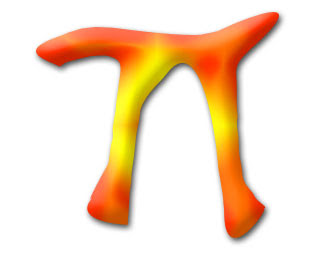
Thoughts on Math Class

I woke up during the night thinking about “basic design elements” in the Kaleidoscopes unit and how much difficulty the kids were having identifying this small piece. As I worked on patterns yesterday to try and create a repeating pattern, I was getting frustrated. When I woke up, I was thinking about the basic element and I was trying to do what I asked my kids to do. Once again teacher learning from students…..
I need to try and create a couple of examples to copy into a PowerPoint so I can show the kids what I am talking about. Who knew Photoshop would be so helpful to my math classes?
National Pi Day….
…and Albert Einstein’s birthday! I own my very own Albert Einstein Action Figure – which makes me a serious math geek, according to my students.
Here’s my tribute to Pi – and I’m working on a few other Photoshop effects as I learn more – t-shirts next year for all the 8th grade math teachers!
The Mathematics of Photoshop
Okay, you’re probably thinking – math? I’m done, no need to read further. But I gotta tell ya, this new lesson by myjanee.com for Photoshop starts us out reading some information about scanners. And now I not only understand pixels (among other things), but the use of the powers of two and RGB and creating the millions of colors available is absolutely fascinating. None of this would have made sense to me even 10 years ago, but as I teach and learn more math, I begin to see it everywhere. I just had no idea there was so much of it within the program itself. I shouldn’t be surprised, because computer programming is all mathematics, but actually seeing it – and having it make sense – is just too beautiful.
